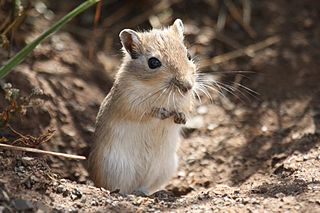
The Mongolian gerbil or Mongolian jird is a small rodent belonging to the subfamily Gerbillinae. Their body size is typically 110–135 mm, with a 95–120 mm tail, and body weight 60–130 g, with adult males larger than females. The animal is used in science and research or kept as a small house pet. Their use in science dates back to the latter half of the 19th century, but they only started to be kept as pets in the English-speaking world after 1954, when they were brought to the United States. However, their use in scientific research has fallen out of favor.

Gerbillinae is one of the subfamilies of the rodent family Muridae and includes the gerbils, jirds, and sand rats. Once known as desert rats, the subfamily includes about 110 species of African, Indian, and Asian rodents, including sand rats and jirds, all of which are adapted to arid habitats. Most are primarily active during the day, making them diurnal, and almost all are omnivorous.
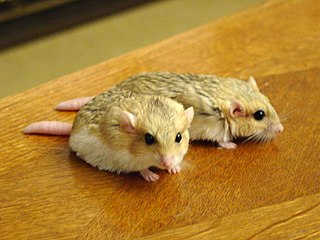
The fat-tailed gerbil, also called the duprasi gerbil or doop, is a rodent belonging to the subfamily Gerbillinae. It is the only member of the genus Pachyuromys. They are frequently kept as pets.

The marbled polecat is a small mammal belonging to the genus Vormela within the mustelid subfamily Ictonychinae. Vormela is from the German word Würmlein, which means "little worm". The specific name peregusna comes from perehuznya (перегузня), which is Ukrainian for "polecat". Marbled polecats are generally found in the drier areas and grasslands of southeastern Europe to western China. Like other members of the Ictonychinae, it can emit a strong-smelling secretion from anal sacs under the tail when threatened.
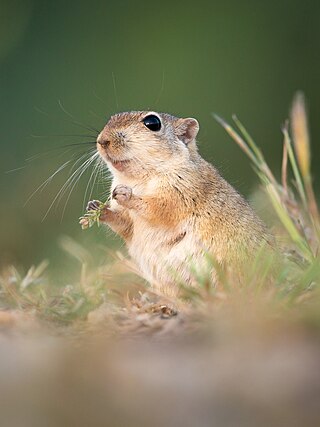
The Indian desert jird or Indian desert gerbil is a species of jird found mainly in the Thar Desert in India. Jirds are closely related to gerbils.
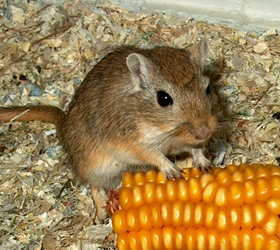
Meriones is a rodent genus that includes the gerbil most commonly kept as a pet, Meriones unguiculatus. The genus contains most animals referred to as jirds, but members of the genera Sekeetamys, Brachiones, and sometimes Pachyuromys are also known as jirds. The distribution of Meriones ranges from northern Africa to Mongolia. Meriones jirds tend to inhabit arid regions including clay desert, sandy desert, and steppe, but are also in slightly wetter regions, and are an agricultural pest.

Sundevall's jird is a species of rodent in the family of Muridae. It is found in Afghanistan, Algeria, Egypt, Iran, Iraq, Israel, Jordan, Kuwait, Libya, Pakistan, Morocco, Niger, Palestine, Oman, Saudi Arabia, Sudan, Syria, Tunisia, Turkey, Western Sahara, United Arab Emirates, Bahrain and possibly Mali. Its natural habitat is hot deserts.

The midday jird, also called midday gerbil, is a rodent species in the family Muridae and native to sandy deserts in Central and East Asia. It has been listed on the IUCN Red List as Least Concern since 2008.
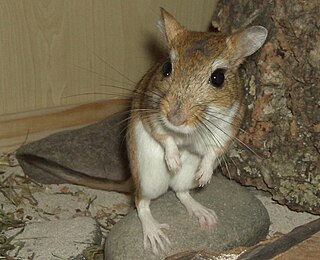
The Persian jird is a species of rodent in the family Muridae found in Afghanistan, Armenia, Azerbaijan, Iran, Iraq, Pakistan, Turkey, and Turkmenistan.
Buxton's jird is a species of rodent in the family Muridae. It is found in the Negev desert and the northern coastal parts of the Sinai peninsula.
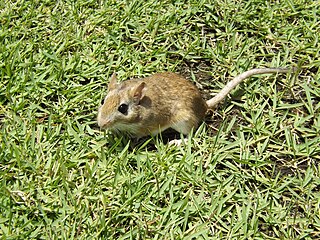
Tristram's jird is a species of rodent that lives in the Middle East. It is named after the Reverend Henry Baker Tristram who collected the first specimens. It is up to 155 mm (6.1 in) long, and lives in burrows in steppes and semi-deserts from Turkey and the Caucasus to Israel and Iran. Records from the Greek island of Kos represent the only gerbils reported from Europe, outside the former Soviet Union. It is a common, widespread species, and is not considered to be threatened.

The wildlife of Libya is spread over the Mediterranean coastline and encompasses large areas of the Saharan desert. The protection of wildlife is provided through appropriate legislation in seven national parks, five reserves, 24 protected areas, two wetlands under Ramsar Convention, and also in other areas. Apart from these, there are also five UNESCO World Heritage Sites related to culture. The most important national parks are the El-Kouf National Park and Karabolli National Park. The well known nature reserves are the Benghazi Reserve and the Zellaf Reserve. The wildlife species recorded in the country are 87 mammals and 338 species of birds.

The northern three-toed jerboa is a species of rodent in the family Dipodidae. It is the only extant species within the genus Dipus. It ranges across Iran, Uzbekistan, Turkmenistan, Kazakhstan, Russia, China and Mongolia. A common species, the International Union for Conservation of Nature rates it as being of "least concern".

The Saharan striped polecat, also known as Saharan striped weasel and Libyan striped weasel, is a species of mammal in the family Mustelidae.

The North Saharan steppe and woodlands is a desert ecoregion, in the deserts and xeric shrublands biome, that forms the northern edge of the Sahara. It extends east and west across Northern Africa, south of the Mediterranean dry woodlands and steppe ecoregion of the Maghreb and Cyrenaica, which is part of the Mediterranean forests, woodlands, and scrub biome. Winter rains sustain shrublands and dry woodlands that form an ecotone between the Mediterranean climate regions to the north and the hyper-arid Sahara Desert ecoregion to the south.

A xerocole, is a general term referring to any animal that is adapted to live in a desert. The main challenges xerocoles must overcome are lack of water and excessive heat. To conserve water they avoid evaporation and concentrate excretions. Some are so adept at conserving water or obtaining it from food that they do not need to drink at all. To escape the desert heat, xerocoles tend to be either nocturnal or crepuscular.
















